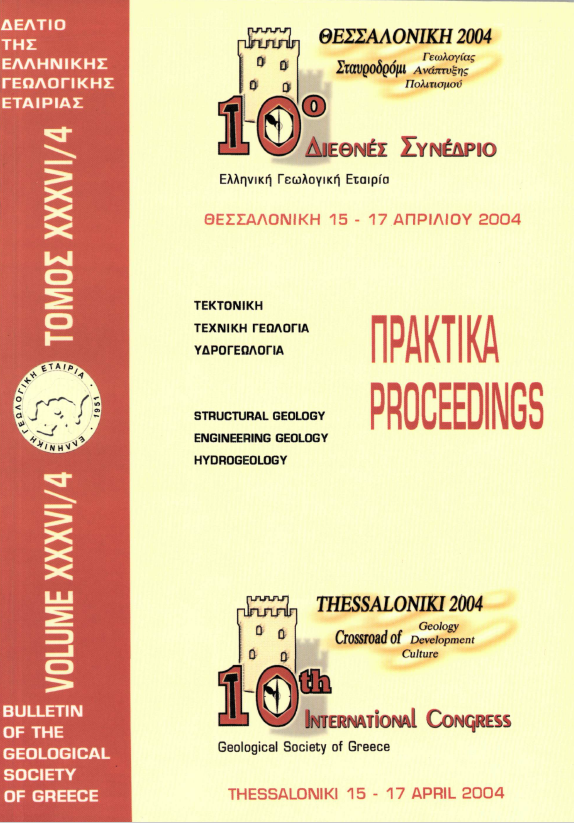INFLUENCE OF THE MICROSTRUCTURE AND MINERALOGICAL COMPOSITION ON THE LABORATORY HYDRAULIC CONDUCTIVITY OF MARLS FROM NORTHERN PELOPONNESE
Abstract
The role which microstructural characteristics and clay mineralogy plays on the saturated hydraulic conductivity value (k) of marls from Northern Péloponnèse, measured in the laboratory, is studied. This value must be taken under consideration when severe geotechnical problems are investigated (e.g. embankment foundations, landslides phenomena involving clayey sediments, soil conditioning e.t.c.) or empirical functions are applied to predict hydraulic conductivity from basic geotechnical properties. The marly samples were analysed by x-ray diffraction (XRD) and by thermo-gravimetric methods (DTA, TG) for the determination of mineralogical composition of clay fraction and by scanning electron microscopy (SEM) for the study of their microstructure. Their basic physical characteristics (grain-size distribution, e, WL, WP, IP, GS, Yd, n) were also determined. The coefficient of permeability (or hydraulic conductivity, k) was measured by the falling head method and the values obtained range between 1.66 10~8 and 1.06 10"6 cm/s, with a few exceptions. Our results indicate that the occurrence of swelling clay minerals in these cohesive marly sediments influences the value of hydraulic conductivity. Because of the double-layer effect not all the pore space contributes to seepage. Furthermore, the aggregation or flocculation of clay minerals and other microstructural characteristics related to the packing of structural constituents (forming an open or tight microstructure), the shape and the distribution of micropores, and the cementation degree of the microstructure are influence factors that affect the value of k. Predicting k, using empirical functions reported by several researchers for cohesive materials, or from simple correlations, as this of k versus clay fraction which is reported in this paper, is not absolutely safe, especially for cemented sediments as marls. Physicochemical factors, as the above-mentioned, play a prevalent role on the hydraulic conductivity value and they cannot be quantified and accounted in existing models.
Article Details
- How to Cite
-
Χριστοδουλοπούλου T., & Τσώλη-Καταγά Π. (2004). INFLUENCE OF THE MICROSTRUCTURE AND MINERALOGICAL COMPOSITION ON THE LABORATORY HYDRAULIC CONDUCTIVITY OF MARLS FROM NORTHERN PELOPONNESE. Bulletin of the Geological Society of Greece, 36(4), 1902–1911. https://doi.org/10.12681/bgsg.16672
- Section
- Engineering Geology, Hydrogeology, Urban Geology

This work is licensed under a Creative Commons Attribution-NonCommercial 4.0 International License.
Authors who publish with this journal agree to the following terms:
Authors retain copyright and grant the journal right of first publication with the work simultaneously licensed under a Creative Commons Attribution Non-Commercial License that allows others to share the work with an acknowledgement of the work's authorship and initial publication in this journal.
Authors are able to enter into separate, additional contractual arrangements for the non-exclusive distribution of the journal's published version of the work (e.g. post it to an institutional repository or publish it in a book), with an acknowledgement of its initial publication in this journal. Authors are permitted and encouraged to post their work online (preferably in institutional repositories or on their website) prior to and during the submission process, as it can lead to productive exchanges, as well as earlier and greater citation of published work.



